 |
| Real 寿山田黄 from my collection. 24.8 grams |
This is in part due to the numerous and sometimes rough definitions for all types of Shoushan stone (寿山石), with some requirements being near impossible to prove. In addition, none of the widely accepted colloquial definitions, even those depicting the exact mineral, are defined legally for trade purposes.
Let's start from the beginning.
What is Shoushan stone?
Shoushan stone come from the Shoushan village in the Eastern part of Fujian province; near the capital Fuzhou.Traced as far back as the Northern and Southern Dynasties period (386-589 AD), artisans in Fujian province have been carving stones mined from the Shoushan village into figurines, landscapes, ornaments and seals (ink stamps). These stones were highly sought after because of their semi-translucent quality and vibrant colors.
Shoushan stones are just one of the Four Great Seal Stones (四大石印); the others being Balin stone (from Inner Mongolia), Changhua stone (from Zhejiang province), and Qingtian stone (also from Zhejiang province). Out of the four, Shoushan is in the highest demand because of it's beauty and because of it's historical significance.
One example of this historical significance and royal fondness for Tianhuang is the last Emperor of China and the Qing dynasty, Puyi. When he fled the palace, the famous set of three Tianhuang seals, linked by chains made of Tianhuang and created by his ancestor the Qianlong emperor (who had a large Tianhuang collection), was one the only non-personal item that he took. People speculate the rationale was that these royal seals helped legitimize his reign as a puppet Emperor in Manchuria for about 14 years at the hands of the Japanese. Later Puyi donated them to the Palace Museum.
 |
| Qianlong's Tianhuang seals |
 |
| The markings of Qianlong's Tianhuang seals |
It is illegal to export these Four Great Seal Stones.
Because of historical significance, all Four Great Seal Stones are actually prohibited from leaving China by customs officials. Yes that is correct; under Chinese law these stones fall under "Precious natural resources", and attempts to smuggle them out of China will be dealt with accordingly.How then, is it possible that you see Shoushan stones being sold online all the time? Well the first thing is, people can always find a way to smuggle things out. The second and largest reason is, that they arent Shoushan stones!
These days, most of what you see is Laos stone being masqueraded as Shoushan stone.
How can this be? The short answer is loose definitions and ignorance.
Defining the composition of Shoushan stones.
Shoushan stone has many varieties, categorized by where they are found in Shoushan village's surrounding areas, and then subcategorized by appearance. As usual, it's always a rough definition. An example would be Shoushan lycee cave stone 荔枝洞石. This is a species of the Alpine stone 高山石 category of Shoushan stone, meaning it is mined high in the mountain. At the same time, lycee stone can come from two mining pits, which is another subcategory. Third is that the appearance should look like the flesh of a juicy piece of moist lycee fruit. Lycee cave stone, by the way, is the second most desired type of Shoushan stone next to Tianhuang.
 |
| A large Shoushan Lycee Cave Stone full of radish silk from my collection. Other examples can be much more white like lycee fruit. |
 |
| I tried my best to capture the radish silk pattern with my phone and a flashlight. A better camera or the naked eye can see the pattern much more clearly. |
 |
| A very translucent piece of Shoushan Lycee Cave Stone carving. Unfortunately my phone's camera is not the clearest, but you can see the floating radish silk pattern even without a flashlight. |
Most shoushan stone is composed of pyrophillite, which is rather opaque. These pieces are cheaper and you will see large carvings made from them. The more expensive species of Shoushan stone, such as Alpine stone and Hibiscus Flower stone, are composed of dickite which is translucent and more rare. You won't see large landscape carvings from these. The Tiankeng species, which is what the famous Tianhuang belongs to, is either nacrite, dickite, or illite and within a range of colors. Most of the time they will be mainly nacrite or illite.
Now, let's say you have some Laos stone, which is mainly dickite. Who is to say where it really came from? If I sell it as Shoushan stone, most people will not be the wiser. People really familiar with it can tell from the colors or patterns, because there are some color combinations or patterns that appear in Shoushan stone but do appear in Laos stone and vice versa. But there could be some instances that you cannot say with the utmost certainty. And for most people interested in collecting, they have no idea, especially because they have no point of reference.
Now let's get back to talking about Shoushan Tianhuang.
Tianhuang is often called the king of stones, because at one point in history Tianhuang was said to be worth three times the value of gold by weight! Actually in recent years, as the average Chinese citizen has more disposable income, the price of Tianhuang at auction has even been recorded at over 1000 times the price of gold!Tianhuang is the most prized and most valuable yellow-orange variety of Tiankeng stones (田坑石), which means "field pit stones". There are other categories of Tiankeng stones such as “white field” Baitian (白田), ”black field“ Heitian (黑田), "crow skin" (乌鸦皮), etc. And of course each category has an exhaustive amount of subcategories. To further confuse things, people often call the Tiankeng variety Tianhuang, probably because of name recognition. So you will sometimes see something labeled as Baitian Tianhuang 白田田黄, which translates to "white field field yellow", and described as a variety of Tianhuang, instead of a variety of Tiankeng. Other times you will see something like Baitian being labeled simply as Tianhuang. Utterly confusing.
Tiankeng are stones found in the riverbed of Shoushan. There is another subcategory for the stones found just above the riverbed, but again...who the heck would ever know the difference? I doubt any seller would ever be honest enough to tell you this stone actually came from 100 feet off the riverbed and let it's value decrease.
As I said before, Tianhuang is mainly composed of Nacrite or Illite, which can be very translucent and is noted for it's "radish silk pattern" 萝卜丝文 and "red tendons" 红腱. Radish silk refers to the white impurities that cause a pattern that looks like a thinly sliced piece of daikon radish, where you can see the small veins creating a beautiful pattern. Red tendons refer to harsh red lines that can appear just below the surface. Tiankeng stones are produced in EXTREMELY small quantities, and it will be difficult to find a piece over 30 grams. As with other pieces of gemological art, the value of piece depends on translucency, color, the quality of the carving, and personal preference. A golden yellow color is the most sought after.
You are getting ripped off once again!
Just like Hetian jade, people will call anything Shoushan stone because of the name. Online I have seen a piece of calcite on Etsy labeled as Shoushan stone and being sold for a lot of money. On eBay I have seen worse. I have seen large pieces of stone being sold as Tianhuang. I am talking pounds here. If you had a one pound piece of Tianhuang you would already be a multi-millionaire, and not slanging it on eBay for a few thousand.
I actually read a study from China which stated that most of the items being sold as Tianhuang are in fact clinochlore. Clinochlore can come in a dark brown, orange, and bright yellow variations, which can somewhat match the varieties of Tiankeng. They can also exhibit a grain somewhat similar to the famed "radish silk" as well as "red tendons". But the pattern in clinochlore to be honest, looks more like little tiny spots than radish silk. Clinochlore is more commonly translucent and the pattern looks more like specks of dirt.
Also, clinochlore cannot be made to shine like Tianhuang when mineral oil is buffed in and is rather dull. (Yes, these days jade and many stones are buffed with mineral oil. In the old days they would use beeswax.)
Here are some pictures pulled from the GIA website for Tianhuang (https://www.gia.edu/gems-gemology/fall-2018-posters-gem-characterization).
 |
| A. Classic piece of Tianhuang relief carving using the skin or rind B. Raw piece of Tianhuang C. The famed radish silk pattern D. Tianhuang exhibiting "red tendons" |
 |
| Baitian 白田 Tianhuang, also known as "Gold wrapped in silver" |
 |
| My Tianhuang 田黄 carving |
 |
| My Black field Tianhuang 黑田 carving |
| Maybe clinochlore? |
 |
| Indonesian Tianhuang |
 |
| Most likely Laos Tianhuang |
The first one I am guessing is clinochlore. It is labeled as Tianhuang, marketing itself as Heitian (black field) Tianhuang. Besides the color and texture, one of the main reasons I am suspect is that this stone is labeled as over 1000 grams, which would basically be worth millions of dollars if it was real Tianhuang sold in China. There would be no reason to put it on eBay for hundreds of dollars.
The second picture is Indonesian Tianhuang. The product was actually labeled as such. This is a stone from Indonesia that has a pleasant appearance and labeled with the words "Tianhuang" to elevate it's prestige. If I recall correctly, it was first called "Sun stone" 太阳石, referring to it's bright yellow to orange color. Later, someone came up with the bright idea of using the Tianhuang buzzword in the name. One way to tell that it is not Tianhuang is that the color is pretty even and you won't get a radish pattern.
The last picture is most likely Laos Tianhuang. However, it is simply labeled "Tianhuang", I suspect, in order to deceive. I suspect that the seller will simply say "I never said it was Shoushan Tianhuang" if confronted.
It suffers from the same fate as Indonesian Tianhuang--labeled as Tianhuang in order to elevate itself. However, this stone is a real problem. Laos stone is primarily dickite, which is one of the minerals that Tianhuang can also be composed of, so some pieces can look similar. The main difference is that you will not find the radish pattern or red tendons on Laos Tianhuang. Laos Tianhuang may have a pattern of white impurities, but the pattern is usually long flowing lines, whose color fades in a gradient fashion. Sellers call this pattern "silk" and not "radish silk".
 |
| An example of the silk pattern in Laos Tianhuang from my own collection |
Another dead giveaway that it was Laos Tianhuang and not Shoushan Tianhuang was that this stone was about 500g and being sold with a mere starting bid of $100. I'm going to monitor it just for fun to see what it sells at. I assume the reserve price is about $1500.
Why is being from Shoushan important?
The same reason why champagne from the Champagne region of France is generally more expensive than champagne from elsewhere like California, even though there are many who argue that California produces wine even better than France. And technically, that "champagne" from outside of Champagne can be called "champagne", it's just "sparkling wine". This is the same reason dickite from Laos cannot be called Shoushan stone.
It boils down again to the historical significance. It's not about the mineral itself, its about the fact that they want to own a piece of Shoushan stone, something which has been coveted by emperors and nobles since the 300's CE.
What does this all mean? What is a good way to not get ripped off purchasing Tianhuang stone?
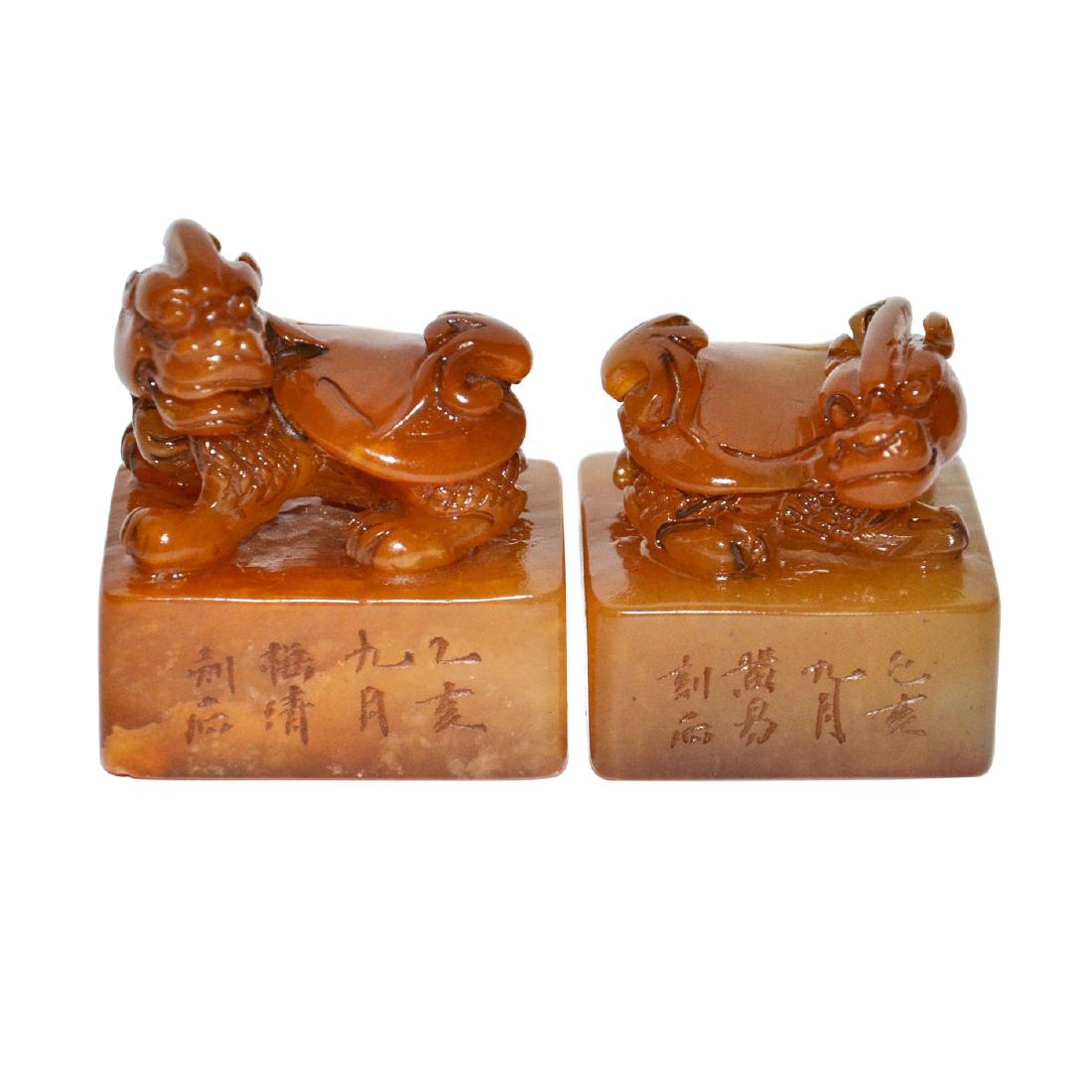 |
| Not Tianhuang. Some form of dickite. Because of the texture, maybe Laos stone, maybe Balin stone, etc., but not Tianhuang |
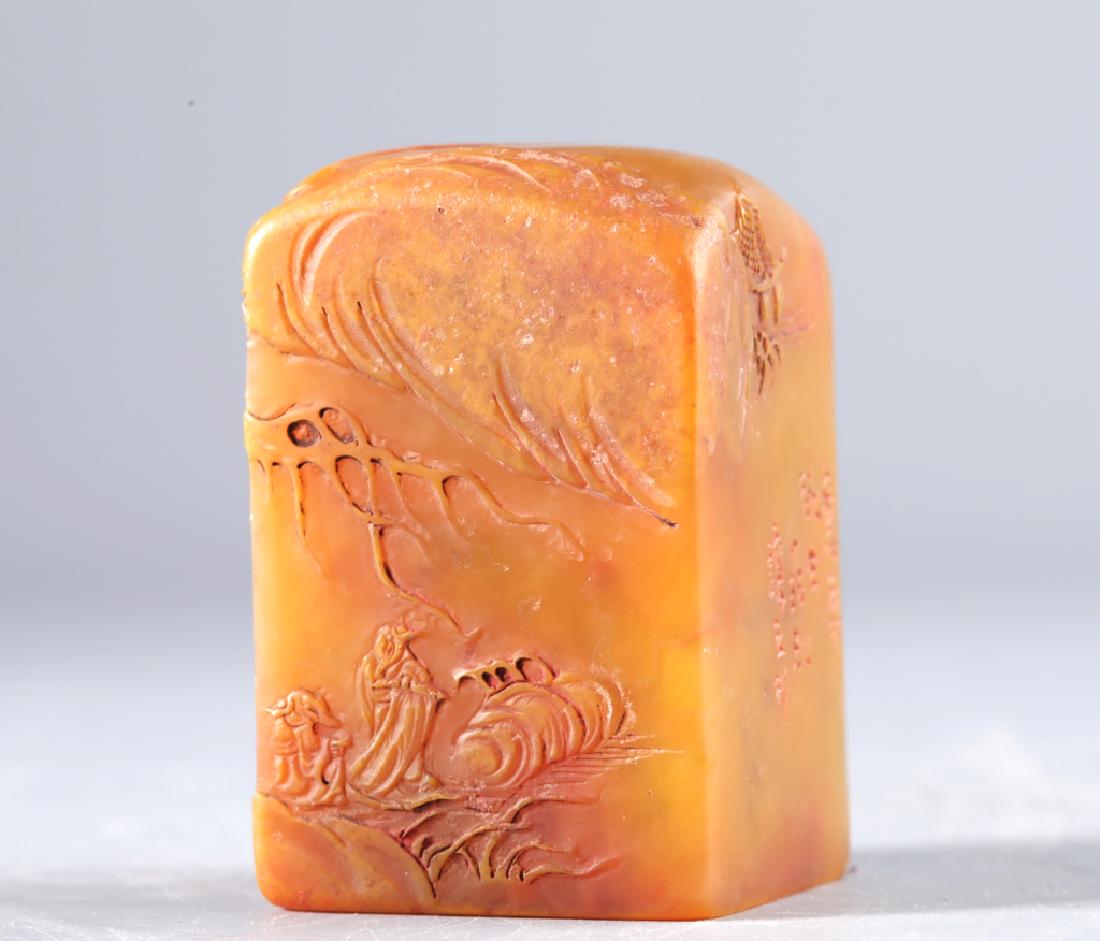 |
| Not Tianhuang. Wrong texture. Probably clinochlore. |
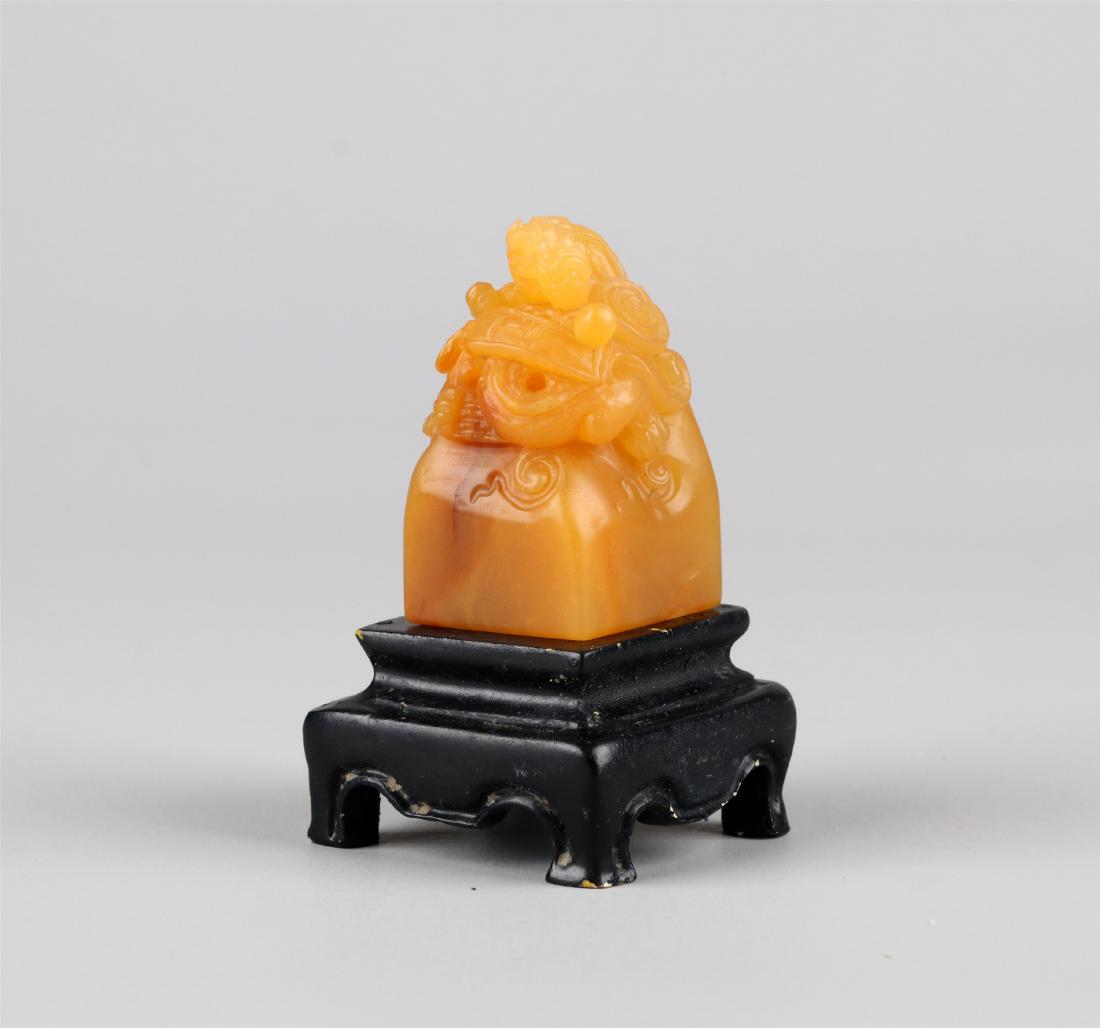 |
| Not Tianhuang. Probably an orange yellow Laos stone, but not even Laos Tianhuang. |
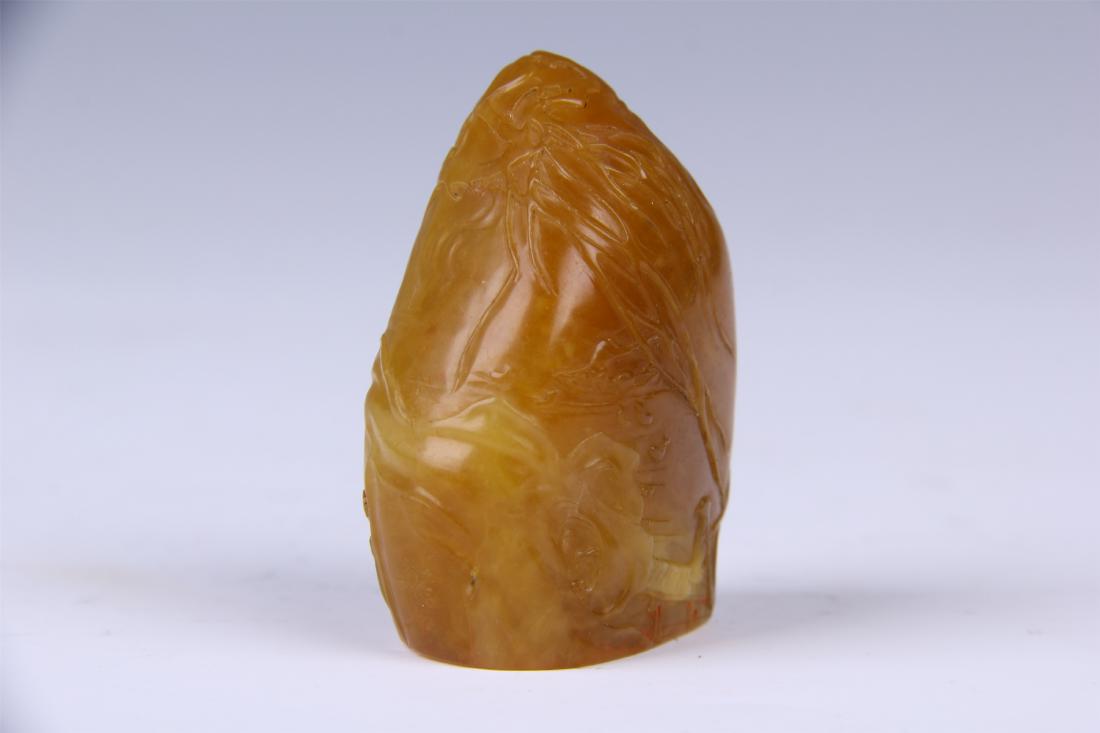 |
| Probably Laos Tianhuang. Might even be considered "Malt Yellow" Laos Tianhuang, which is rare and the most expensive form of Laos Tianhuang. |
The first thing to do is to get a good baseline for what is and what isn't Tianhuang visually. Above are some more examples and hopefully all the pictures in this whole article will get you started. It's pretty easy to distinguish the ridiculous claims after a while.
Now this last picture I included might be difficult. It does have a cloudy texture or pattern which an overeager collector might tell himself resembles radish silk, but it looks more like fluffy bits of cotton than the thin veins of a piece of sliced radish. There is also a large silk ribbon going across horizontally, which is typical of Laos Tianhuang. A lot of times Laos Tianhuang, due to being mostly dickite, has large areas that are too translucent to be Shoushan Tianhuang.
I fully admit I could be wrong, but generally this is the case and I think most experts would agree with me.
The second thing I would do is to look at the size piece, which was 96 grams. That is huge for Shoushan Tianhuang. Very rare these days as Tianhuang sources are depleting fast. Once again, I doubt it would be for sale at this price and at this place.
This knowledge so far will at least keep you from purchasing a piece of clinochlore for $80,000 USD, which I unfortunately saw someone do on an online auction site. Combined with the buyer's premium we are talking about over $100,000 USD for something that cost $100.
The best way for someone to deceive you in purchasing Tianhuang is to take some Laos stone and make a small piece, like 20 grams and claim it is Shoushan Tianhuang. The color and sheen will be acceptable, so you will have to really inspect the radish pattern.
But what if there is no radish pattern? Not every piece of Tianhuang exhibits this trait. So how can you know for sure? Ultimately, I have to say there could be situations where you just don't know for sure without lab analysis.
Labs in China specializing in Shoushan stone will be able to certify based on whether or not the exact chemical composition of the stone falls within their standards for Shoushan stone that they have acquired through decades of testing data.
If you send this to GIA, GIA can tell you that it is natural and that it is dickite or nacrite etc., but I don't believe they will have the data to label it "Shoushan stone" or "Tianhuang stone".
So you need a certificate from a reputable lab in China, certified by government agencies with a photo that you can look up on the company website. This will ensure that the certificate is real and not a useless piece of paper. Beware, sometimes manufacturers issue their own certificates, but I don't put faith in them even though they might be legitimate.
The most reputable lab for Shoushan stone is not surprisingly in Fuzhou, Fujian which is right next to Shoushan. This is because all the factories send their stuff to this local place and they want to keep their reputation high. They don't want to lose their reputation and make a few extra dollars by certifying something that shouldn't be certified; the stone collecting world in China is very small.
The most reputable lab for Shoushan stone is not surprisingly in Fuzhou, Fujian which is right next to Shoushan. This is because all the factories send their stuff to this local place and they want to keep their reputation high. They don't want to lose their reputation and make a few extra dollars by certifying something that shouldn't be certified; the stone collecting world in China is very small.
This is a similar situation to Hetian jade. The government certified labs in Xinjiang are the most reputable for this sort of thing.
So if I am looking for Shoushan Tianhuang this is what I would do in this order
1. Is it over 50 grams? If it is, it should be tens of thousands of dollars. If it's not, then it's probably fake.
2. Visually inspect the color and texture and all the things I described above. You might not be able to do so well online. You might take a chance if it's not too expensive.
3. Look for a certificate. Check to see if it has a QR code or an ID number you can use to look it up on the company website. Here is one of my certifiates as an example. The back of the certificate you can see www.fzsssac.com which is the FuZhou ShouShan Stone Appraisal Center (FZSSSAC). If you look at the front of the certificate you will see "4185969T" stamped at the bottom. Go to the www.fzsssac.com and navigate to the certification section, type in the ID number and the website will pull up this exact certificate, verifying it's real.
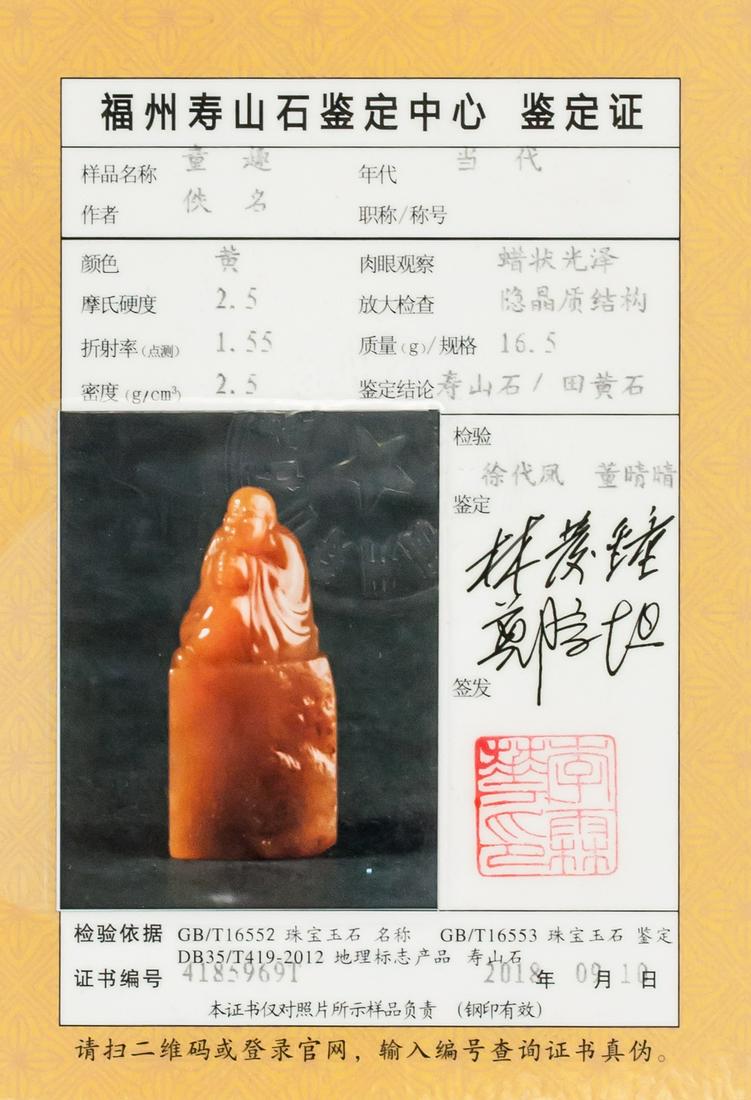
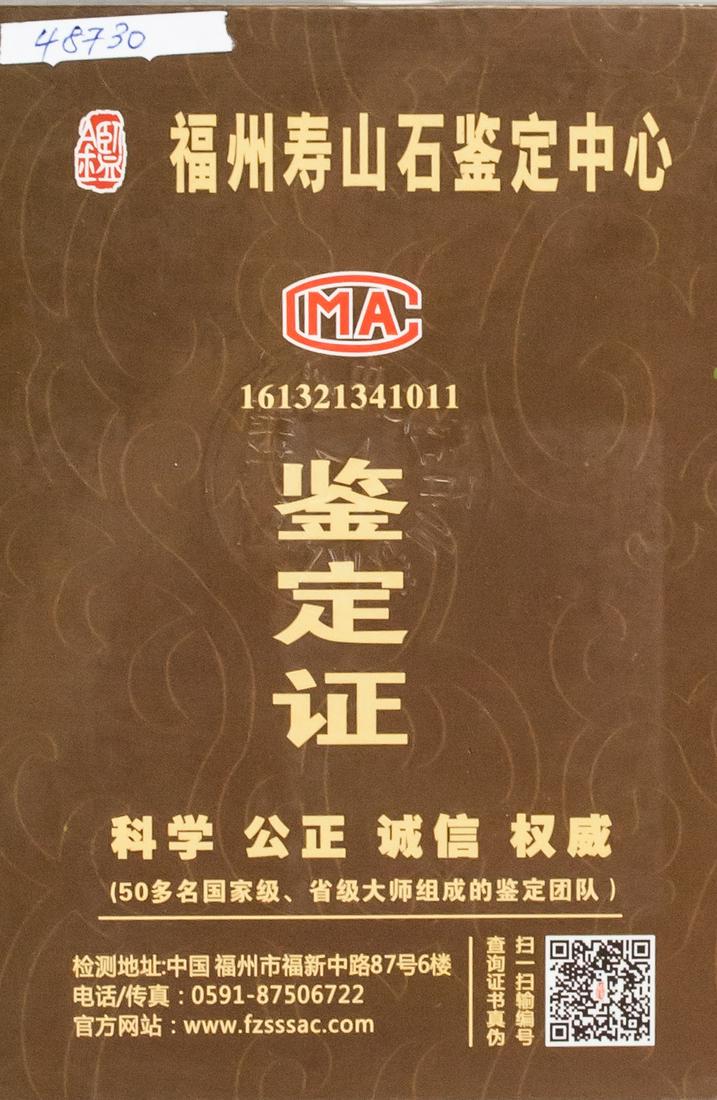
Collecting Shoushan stone is said to be a noble hobby, more prestigious than jade collecting. People truly appreciate the beauty of these minerals as opposed to the flashiness and fashion conscious mentality of jade. However, both share some dangers so be careful!































